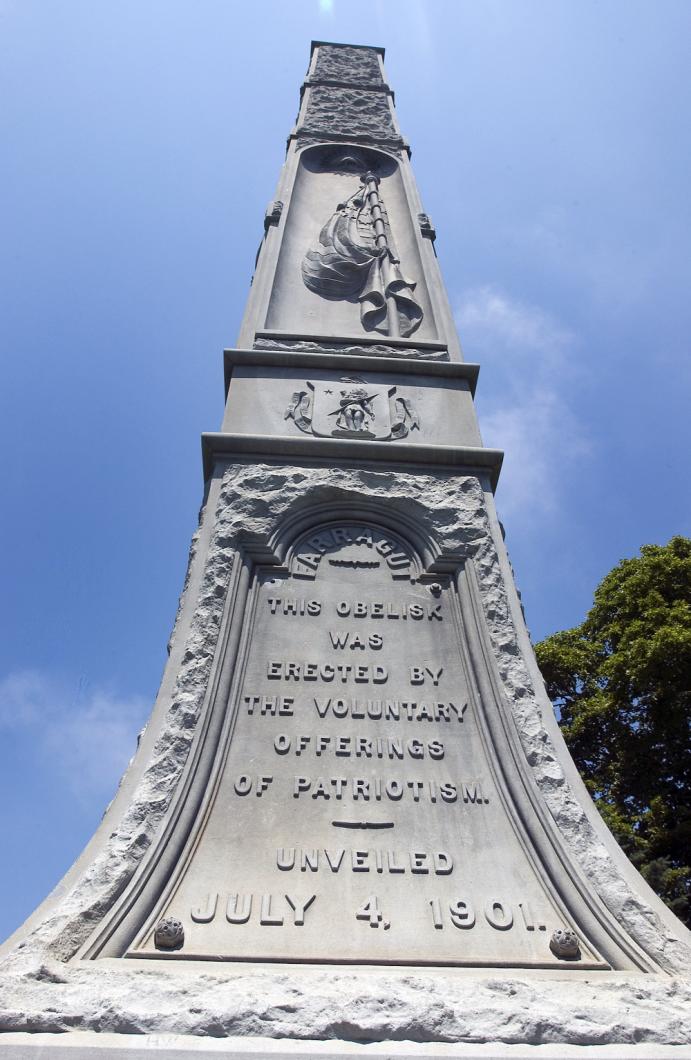Patriotism, Vineyard history and the meaning of the Fourth of July holiday remain vibrant at Memorial Park in Edgartown. The one-and-one-half acre park has never looked finer. The Civil War-era cannons and cannonballs, the whaling-era trypot and other aging features of the park were just recently repainted.
Tomorrow is the 108th birthday of the dedication of the park and the unveiling of a tall bronze obelisk, a tribute to the service of veterans, men and women, who served in the Civil War, a war that was felt deeply by the residents of the Vineyard.
For Tom Benedict, 58, of Edgartown, a local housepainter, the park has been a special spot for years. He feels it a great honor to be a part of the park’s rebirth. “I think it is the nicest spot in Edgartown. I bicycle by it often and there is one bench that I like to sit on and watch the people go by.”
Mr. Benedict painted the historical features at the park. To pay for his work and the work of others in fixing the park, $3,272 came from the voters when they approved the Community Preservation Act funds at their annual town meeting in the spring. Mr. Benedict scraped off the old paint, and for much of the month of June, repainted fresh coats. He said the foul weather made the project take a lot longer than he expected.
In addition, the cannons received new foundations, the benches were powerwashed, and the planters around the park were fixed.
“Someone once said that ‘A land without memorials is a land without liberty.’ Every spot in a land that marks the achievement of some heroic deed is, to that land, a perennial fountain from which flow influences to strengthen the patrioitism of its people,” said Rev. W.H. Allen, one of the many local ministers who spoke at the park’s original dedication ceremony on July 4, 1901.
The speeches were long and many, but throughout the service, the event honored all Vineyarders who served and the relationship the community had with the war. During the Civil War, prior to 1880, Oak Bluffs was a part of Edgartown.
There was not a Vineyarder in the time of the Civil War who did not have a friend or relative whose life was not at risk during the war. There were Vineyard sailors and whalemen at sea. And then there were those who were on the battlefield.
Today, the Civil War is too easily portrayed as having taken place somewhere else, but the wrath of war was felt deeply by Island loved ones.
Two factors permanently disabled the great New England whaling ships and likewise dramatically impacted the Island economy: the discovery of underground oil in Pennsylvania and the destruction wrought by at least eight Confederate raiders during the Civil War. These ships traveled the Pacific and Atlantic Oceans, sinking whale ships. Many New Bedford, Nantucket and Martha’s Vineyard whale ships were captured, burned and sunk.
The impact of the war on both livelihoods and the economy was huge. Thus, there was a great deal of impetus, after the war was over, to honor those who served and brought the fighting to an end. Many spirited Islanders participated in the building of the memorial park. Efforts were made by the Soldiers, Sailors and Women’s Memorial Park Association.
Enoch C. Cornell created the park. From a Vineyard Gazette article of 1901: “He was the inceptor of the purchase, and reservation of the park and the elevation of the monument upon it. His comrades of battle from Cottage City and similar organizations have aided him in every possible way to an extent which none of the other survivors of the Civil War might have secured . . . .”
The 25-foot tall white bronze obelisk, made by the Monumental Bronze Company of Bridgeport, Conn., pays tribute to the men and women who served in that war. The bronze shaft weighs 6,100 pounds and sits on a granite pedestal and blocks weighing at least 11 and one-half tons, bringing the total weight of the monument to almost 30,000 pounds. The names of many veterans are cut in the granite. Viewed from any direction, the monument is an impressive sight.
“In memory of the brave men and noble women who, amid the darkness and sorrows of war, brought light and liberty to our beloved country,” is written on one side.
A trypot, a large black metal pot used aboard whaling ships, is in full view at the park. It is being used as a flower pot, filled to the brim with impatiens. The trypot came from the bark Mattapoissett, owned by Walter Osborn of Edgartown. The ship was dismantled in 1898 at the foot of Main street, where today stands the Edgartown Yacht Club, formerly known as Osborn Wharf.
Memorial Park was at one time the site of the Martha’s Vineyard Railroad station, when there was railway service between Oak Bluffs and Edgartown. The railroad stopped running in 1896. The public park was opened in 1898.
The dedication of the park in 1901 was an all-Island affair. The Vineyard Haven Band played, along with other musicians. There was the singing of the Star Spangled Banner by Mrs. E.F. Heddon, and accompanied by the horns in the band. Thirty-two veterans of the Henry Clay Wade Post No. 201 of Cottage City attended. And there were speeches, lots of speeches.
The Vineyard Gazette reported of the day: “Flags flew from many stalls in the town and quite a number of stores and houses made an attempt at decoration.
The completion of the monument in New Memorial Park, dedicated to heroes of the Sea and Land, when at war, was celebrated yesterday. A gala day! An occasion which Edgartown may well class as notable in her town history and pride herself upon as being an indication of unanimity, veterans, citizens, visitors, soldier or sailor. . . .”







Comments
Comment policy »